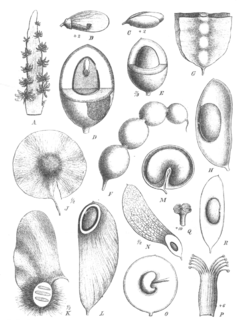
Khaudum National Park is an isolated Nature Reserve situated in the Kalahari Desert at the west of the Caprivi Strip in northeast of Namibia. It is a very remote and inaccessible reserve but is home to some magnificent animals such as the lion and the hyena. The park also has a campsite for visitors.

The dark long-tongued bat is a species of bat from South and Central America. It was formerly considered monotypic within the genus Lichonycteris, but is now recognized as one of two species in that genus, along with the pale brown long-nosed bat. It is small species of bat, with adults weighing 6–11 g (0.21–0.39 oz) and having a total length of 46–63 mm (1.8–2.5 in).
Deguelia utilis, syn. Lonchocarpus utilis is plant species in the family Fabaceae. It is native to the tropical forests of Peru, as well as of Brazil and Guyana, growing from 100–1,800 metres (330–5,910 ft) above sea level.

Lonchocarpus urucu, or barbasco, is plant in the family Fabaceae. It is native to the tropical forests of Peru, as well as of Brazil and Guyana, growing from 100–1,800 metres (330–5,910 ft) above sea level. It was also recorded in Venezuela.
Lonchocarpus calcaratus is a species of legume in the family Fabaceae. It is found in Costa Rica and Panama. It is threatened by habitat loss.

Lonchocarpus is a plant genus in the legume family (Fabaceae). The species are called lancepods due to their fruit resembling an ornate lance tip or a few beads on a string.
Lonchocarpus chiricanus is a species of plant in the family Fabaceae. It is found only in Panama.
Lonchocarpus kanurii is a species of legume in the family Fabaceae. It is found in Kenya and Somalia. It is threatened by habitat loss.
Lonchocarpus minimiflorus is a species of plant in the family Fabaceae. It is found in Costa Rica, El Salvador, Guatemala, Honduras, Mexico, and Nicaragua.
Lonchocarpus molinae is a species of plant in the family Fabaceae. It is found only in Honduras.
Lonchocarpus phaseolifolius is a species of plant in the family Fabaceae. It is found in Costa Rica, El Salvador, Guatemala, Honduras, and Nicaragua.
Lonchocarpus phlebophyllus is a species of plant in the family Fabaceae. It is found in Costa Rica, Guatemala, Honduras, and Nicaragua.
Lonchocarpus retiferus is a species of legume in the family Fabaceae. It is found in Honduras and Nicaragua.
Lonchocarpus sanctuarii is a species of plant in the family Fabaceae. It is found only in Honduras, Mexico and San Salvador.
Lonchocarpus santarosanus, the chapelno blanco, is a species of plant in the family Fabaceae. It is found in El Salvador and Guatemala. It is threatened by habitat loss.
Lonchocarpus trifolius is a species of plant in the family Fabaceae. It is found only in Honduras.
Terua vallicola is a species of legume in the family Fabaceae. It is found only in Honduras.

Helicia is a genus of 110 species of trees and shrubs, constituting part of the plant family Proteaceae. They grow naturally in rainforests throughout tropical South and Southeast Asia, including India, Sri Lanka, Indochina, Peninsular Malaysia to New Guinea and as far south as New South Wales.
Lonchocarpus salvadorensis, the Sangre de Chucho, is a plant species in the genus Lonchocarpus.





